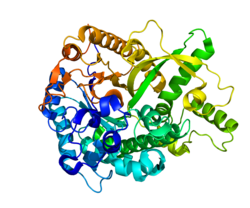Top Qs
Timeline
Chat
Perspective
GBA3
Protein-coding gene in the species Homo sapiens From Wikipedia, the free encyclopedia
Remove ads
Cytosolic beta-glucosidase, also known as cytosolic beta-glucosidase-like protein 1, is a beta-glucosidase (EC 3.2.1.21) enzyme that in humans is encoded by the GBA3 gene.[3][4]
Remove ads
Function
Cytosolic beta-glucosidase is a predominantly liver enzyme that efficiently hydrolyzes beta-D-glucoside and beta-D-galactoside, but not any known physiologic beta-glycoside, suggesting that it may be involved in detoxification of plant glycosides.[4] GBA3 also has significant neutral glycosylceramidase activity (EC 3.2.1.62), suggesting that it may be involved in a non-lysosomal catabolic pathway of glucosylceramide metabolism.[5]
Remove ads
See also
References
Further reading
External links
Wikiwand - on
Seamless Wikipedia browsing. On steroids.
Remove ads



